|
KATMAI
Fure's Cabin Historic Structure Report |

|
III. APPENDIX
A. NATIONAL REGISTER NOMINATION
UNITED STATES DEPARTMENT OF THE INTERIOR
NATIONAL PARK SERVICE
NATIONAL REGISTER OF HISTORIC PLACES
INVENTORY — NOMINATION FORM
FOR FEDERAL PROPERTIES
NAME:
Fure's Cabin
LOCATION:
Katmai National Park and Preserve
King Salmon
Bristol Bay Div.
Alaska 99613
CLASSIFICATION:
Category: Buildings
Ownership: Public
Public Acquisition: N.A.
Status: Unoccupied
Accessible: No
Present Use: Government
AGENCY:
Katmai National Park and Preserve
P.O. Box 7
King Salmon, Alaska 99613
LOCATION OF LEGAL DESCRIPTION:
National Park Service files, Alaska Regional Office
2525 Gambell Street, Room 107
Anchorage, Alaska 99503-2892
REPRESENTATION IN EXISTING SURVEYS:
List of Classified Structures, National Park Service
June 1976 (Federal)
National Park Service, Alaska Regional Office
2525 Gambell Stree, Rm. 107; Anchorage, Alaska 99503-2892
DESCRIPTION:
Condition: Good, Altered, Original Site
DESCRIBE THE PRESENT AND ORIGINAL (IF KNOWN) PHYSICAL APPEARANCE
Fure's cabin is about 100 feet back from the water on the north shore of the Bay of Islands, Naknek Lake, North Arm, at the start of the portage trail to Grosvenor Lake. The site consists of a cabin, windmill tower, storage shed, remains of a dory, and an outhouse. Dates of construction for the windmill tower, shed, dory, and outhouse are not available. Ownership fell to National Park Service upon the death of Roy Fure in 1962. The cabin is presently used as a patrol cabin; it is not open to the public. Structures at the site are described below.
1. Fure's cabin is a log cabin with a single room, measuring about 15' x 20'. Logs for construction of the cabin are evidently from the immediate vicinity. All the wood was cut with hand tools and the craftsmanship is of exceptional quality. The walls are hand-hewn squared logs with dovetail notching at the corners. The roof contains planking made from split logs, covered with a layer of tin. Split logs also form the floor. Furnishings include a woodburning stove, a bed, built-in shelves, and paraphernalia. Minor alternations, mainly the addition of a screen door and wooden shutters, were made to the cabin sometime between 1976 and 1982. These alterations are in keeping with the character of the cabin. The cabin may have had a sod roof in earlier years; the tin for the roof was brought to the site about 1930. While the date of construction is not certain, it is believed to be 1916, and was certainly before 1926. The condition of the cabin is good. (Photographs attached.)
2. A windmill tower, standing about 50' high and measuring about 15' x 15', is about 20' north of the cabin. The windmill itself is gone. The inside of the tower was used for storage and a great many artifacts are stored in the tower, including barrels, bottles, tools, animal traps, food, wooden boxes, clothing, and a few documents. Construction of the tower is of wood planing and sheet metal. Condition of the tower is good.
3. A storage shed for lumber, measuring about 4' x 15' and standing about 4' high, is about 50' south of the cabin. This structure consists of 2x4 studding and a tin roof. It was built without walls. Condition of the shed is good.
4. The remains of Mr. Fure's dory lie on a sandy beach west of the cabin. More nearly in front of the cabin is an area that appears to have been dug out for use as a boat pullout. The dory is in ruins.
5. An outhouse is about 20' southeast of the cabin. It is constructed of planed lumber and poles. The condition is good.
SIGNIFICANCE:
Period: 1900-
Areas of Significance: Architecture, Craftsmanship
STATEMENT OF SIGNIFICANCE
Fure's Cabin is significant in that it reflects excellent craftsmanship and gives evidence of the lifestyle of many early 20th-century non-native Alaskans. While the cabin itself best demonstrates the craftsmanship and architectural aspects of the site's significance, all the structures and historic paraphernalia at the site are important in demonstrating the lifestyle of Roy Fure, a trapper-prospector.
The level of craftsmanship achieved on the cabin is exceptional. Overall dimensions of the structure vary little more than one-half inch at opposing wall elevations—remarkable considering the age of the building. All the logs used in the building were hewn by hand to a rectangular shape; they also are dimensionally consistent. Joints between wall logs and at dovetailed corners were carefully crafted to fit tightly and are still tight today; little chinking was required or used. The cabin's fine and careful construction is evidenced by its excellent state of preservation despite its being uninhabited for twenty years in a harsh environment.
Certain aspects of the cabin, mainly the dovetailed corners and handhewn roof and floor slabs, appear to show Russian or Scandinavian influence in Alaskan architecture. This detailing is similar to construction techniques used in a Russian Orthodox Church in the Lake Clark region of Alaska (the Kejik Church), and the Russian Bishop's House, a National Historic Landmark in Sitka, Alaska. Mr. Fure was a Lithuanian-Russian and must have learned methods of construction in his homeland, as these methods are rare in Alaska. This is the only cabin in the Katmai area constructed in this fashion (with the possible exception of another cabin constructed by Mr. Fure, which has not been examined as yet).
Fure's Cabin exemplifies the early 20th-century trapper-prospector lifestyle and gives evidence of the activities and lifestyle of Roy Fure. The site has the number and kinds of outbuildings characteristic of trapper-prospector sites built in many regions of Alaska during this time period: a one-room log cabin, elevated cache, wood shed, and outhouse. The construction materials, log and split-logs, rather than milled lumber, are also typical of the era in which the cabin was built.
The historic paraphernalia and furnishings, including traps, axes, tools, built-in wood shelves, cardboard boxes flattened to cover interior walls, and a wood cookstove are characteristic of a trapper-prospector residence, though the quality and number of items show touches of a more permanent nature than most. A number of artifacts are inventions or modifications made by a person with little cash income, far from commercial outlets, and whose subsistence was largely from nature. These include a lamp shade made of tree bark, gas-cans flattened for use as roofing, and a shower nozzle made from a bacon can.
Fure lived in San Francisco before moving to Alaska.1 The Alaska Packer's Association recruited and transported workers from San Francisco each summer season and Fure was probably one of the thousands lured to Alaska to fish commercially or work in fish canneries or salteries.2
There are conflicting reports about the year Fure moved to the Bay of Islands. In 1954 archeologists conducting research in the area interviewed Fure. According to their report Fure lived below Chignik, Alaska, in 1912, but moved to the present Katmai National Park and Preserve shortly thereafter. He described several villages in the area to them, from first-hand experience beginning in 1914, and from hearsay knowledge for the years prior to that— which leads one to believe he moved to the region in 1914.3
In 1938, however, the National Park Service investigated Fure's right to land within the then monument, and the investigator cited a later date for Fure's arrival. A.C. Kinsley, Special Agent, Mount McKinley National Monument, reported that Fure moved into the Katmai region about 1926, and that his wife, Fannie, lived there only two years, 1926-1927, before moving to Kodiak.4 Other National Park Service records indicate he moved to the Katmai area in 1916.5
At any rate, Fure and his wife Fannie Olson, an Aleut from Naknek, settled at the Bay of Islands and had two children, a son Alexander and a daughter Nola, born in the 1920's.6 About 1941 Alexander Fure helped his father build another cabin at American Creek, where Roy Fure was reportedly doing some occasional prospecting.7
Pay receipts, oral interviews, and the artifacts at the site indicate Fure worked at several occupations on a temporary or seasonal basis—as a trapper, prospector, carpenter, cannery-worker, laborer, and fisherman. He was described as a person handy with wood and machinery, and a good carpenter. He had a wind generator, a windmill, a radio, and a plethora of tools at the cabin. To obtain supplies, he used a dory in summer and skis in winter to travel 55 miles to Naknek and the nearest commercial establishments. In Naknek and South Naknet area he had several friends with whom he'd stay when in town.9
Writing from a hospital on September 4, 1962, Fure authorized his daughter Nola and his son-in-law Bobby Hoffman to use and live in his three cabins, including the one at the Bay of Islands, the cabin at American Creek, and another one located outside the monument boundaries.10 Because he was a citizen of Russia and had never obtained United States citizenship, however, ownership of the cabins at American Creek and the Bay of Islands reverted to National Park Service upon his death in October, 1962.11
Fure's cabin remains in good condition with a great many artifacts still at the site. The relative isolation of the site, far from any major population centers and accessible only by float plane or boat, has preserved the integrity of the site. At least one bear over the years, however, and a few people have entered the cabin and disturbed then rearranged historic objects.12 Park rangers use the cabin while on patrols.
The National Park Service has developed a stabilization plan for the building. Stabilization work is scheduled to begin in the summer of 1985.
1. Mike Shpasnikoff, Victor Monsen, interviews with Joaqlin Estus, Brooks Camp and Naknek, Alaska, June, 1982.
2. Monsen to Estus, June, 1982. For more information on the history of the Katmai area, see: John A. Hussey, Embattled Katmai: A History of Katmai National Monument, (San Francisco: National Park Service, 1971). An overview of the fishing industry in particular is given in James E. Hawkins, Eliabeth A. Daugherty, "The Silver Fleece: An Economic Study of the Bristol Bay Region," (Alaska Rural Development Board, Juneau: 1958) pp 3-4. The records of the Alaska Packer's Association, Alaska Historical Library, Juneau, Alaska, provide more specific information on the industry.
3. Wilbur A. Davis, with assistance of James W. Leach, "Archeological Investigations of Inland and Coastal Sites of the Katmai National Monument, Alaska," (Unpublished manuscript, National Park Service, Alaska Regional Office, Anchorage, Alaska, March 4, 1954) p. 69.
4. A.C. Kinsley, Special Agent, Division of Investigations, Mount McKinley National Park, to Commissioner, General Land Office, Jan. 18, 1940, Park files, Katmai National Park and Preserve, King Salmon, AK.
5. Merrill J. Mattes, Chief, Office of History and Historic Architecture, Western Service Center, National Park Service, to General Superintendent, Alaska Cluster Office, National Park Service, Feb. 11, 1970; Superintendent, Mount McKinley National Park, to Regional Director, Western Region, Jan. 6, 1964 (National Park Service files, Katmai National Park and Preserve, King Salmon, Alaska).
6. Kinsley, p. 3.
7. Monsen to Estus, June, 1982.
8. Bob Hatfield, Victor Monsen, Mike Shapsnikoff, interviews with Joaqlin Estus, Brooks Camp and Naknek, Alaska, June, 1982.
9. Roy Fure, letter "To Whom it May Concern," Sept. 4, 1962, (Park files, Katmai National Park and Preserve, King Salmon, AK).
10. Thomas F. Flynn, Jr., Director, Western Region, National Park Service, to U.S. Senator E.C. Bartlett, Park files, Katmai National Park and Preserve, King Salmon, AK, Kinsley.
11. David E. Bogart, Park Ranger, Mount McKinley National Park, to Nola L. Hoffman, Park files, Katmai National Park and Preserve, King Salmon, AK, January 27, 1984.
MAJOR BIBLIOGRAPHICAL REFERENCES:
1. "Archeological Investigations of Inland and Coastal Sites of the Katmai National Monument, Alaska," by Wilbur A. Davis (National Park Service, 1954).
2. List of Classified Structures Inventory, Robert Carper, DSC, NPS; 1976.
3. Interviews with Mike Shapsnikoff, Bob Hatfield, and Victor Munson, Naknek, Alaska; June 1982.
4. Park files, Katmai National Park and Preserve, King Salmon, Alaska.
GEOGRAPHICAL DATA:
The site is a 2.4 acre area located at approximately 58 40' 13"N, 155 25' 50"E, on the north shore of the Bay of Islands. Boundaries are commencing at a point (approximate UTM Coordinates: 6505670 N, 359250 E), at mean high water 115 feet N 55 00' E. from the start of the Portage Trail from the Bay of Islands to Grosvenor Lake thence 240 feet N 20 00' W, thence 240 feet S 70 00' W, (roughly parallel to the shore), thence 440 feet S 20 00' W, to a point approximately 110 feet from shore, thence 110 feet N 70 00' E, thence 425' N 55 00' E (along the shoreline) to the point of beginning. (See attached map and drawing.)
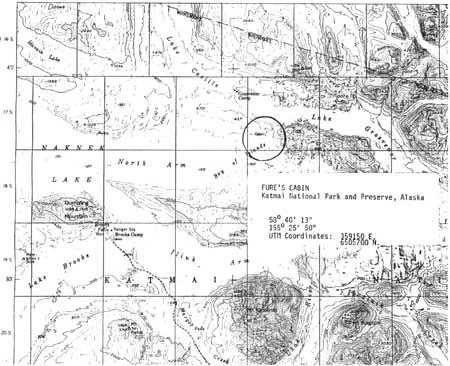
|
| (click on image for a PDF version) |
FORM PREPARED BY:
Joaqlin Estus, Historian
National Park Service
2525 Gambell Street, Room 107
Anchorage, Alaska 99503-2892
271-4165
July 16, 1984
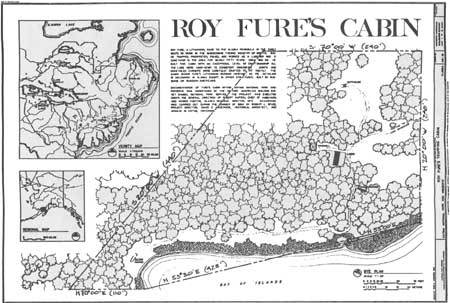
|
| Roy Fure's Cabin. (click on image for a PDF version) |
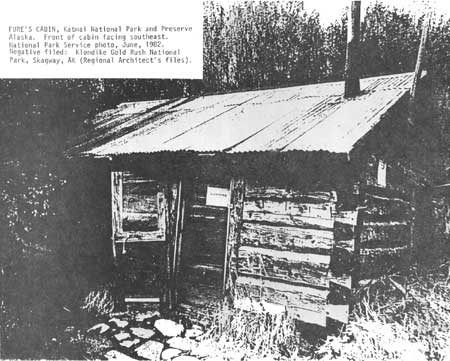
|
| FURE'S CABIN, Katmai National Park and Preserve Alaska. Front of cabin facing southest. National Park Service photo, June, 1982. Negative filed: Klondike Gold Rush National Park, Skagway, AK (Regional Architect's files). |
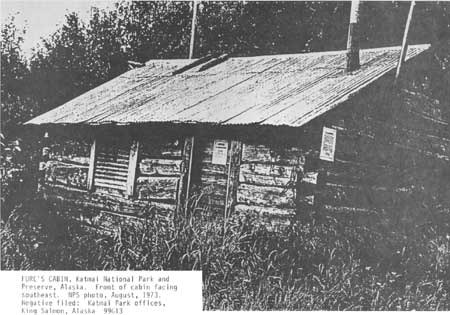
|
| FURE'S CABIN, Katmai National Park and Preserve Alaska. Front of cabin facing southeast. NPS photo, August, 1973. Negative filed: Katmai Park offices, King Salmon, Alaska 99613. |
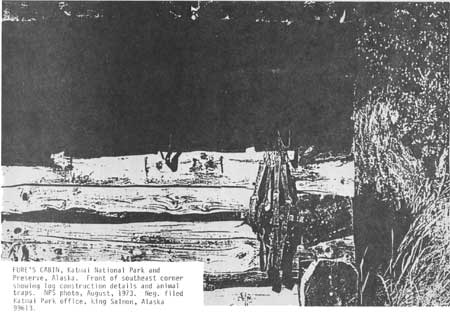
|
| FURE'S CABIN, Katmai National Park and Preserve Alaska. Front of southeast corner showing log construction details and animal traps. NPS photo, August, 1973. Neg. filed Katmai Park office, King Salmon, Alaska 99613. |

|
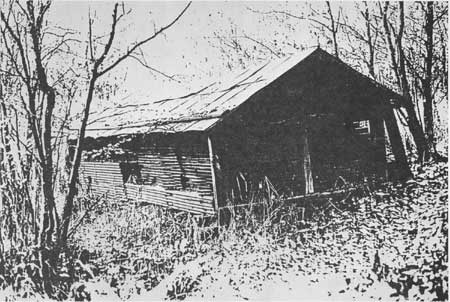
|
| FURE'S CABIN, Katmai National Park and Preserve Alaska. NW view of storage shed for lumber. NPS photo, Sept. 1983. Negative filed at Alaska Regional Office, NPS, Anchorage, Alaska. J. Estus. |
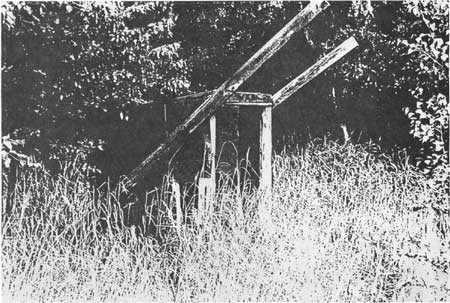
|
| FURE'S CABIN, Katmai National Park and Preserve Alaska. Outhouse located about 20' southeast of cabin. NPS photo, June, 1983. Negative filed: Regional Architect's files, Klondike Gold Rush NHP, Skagway, AK. D. Snow. |
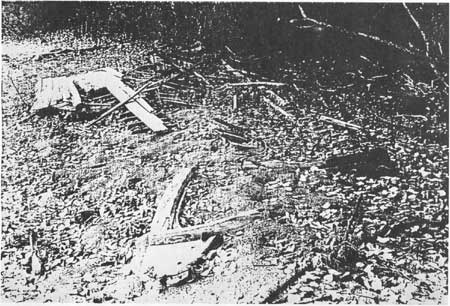
|
| FURE'S CABIN, Katmai National Park and Preserve Alaska. Front of Remains of dory on sandy beach west of the cabin itself. NPS photo, Sept. 1983. Neg. filed Alaska Regional Office, Anchorage, Alaska. J. Estus. |
| <<< Previous | <<< Contents>>> | Next >>> |
katm/fures_cabin/appa.htm
Last Updated: 26-Mar-2008